Ĉi tie vi trovas kelkajn librojn en la angla lingvo, kiuj rilatas al Esperanto (tradukoj el Esperanto kaj anglaj libroj kun Esperanto kiel temo).
On this page, you will find books in English that are either translated from Esperanto or have Esperanto as a topic.
1. Anglaj versioj de Esperanto-libroj
English versions of books in Esperanto

Sandra Haber:
Baxter Speaks! Baxter parolas!
ISBN 9781595694676
60 p. Mole bindita libro.
Rakonto en la angla kun paralela traduko en Esperanto.
Tradukis Raúl J. García
Baxter Speaks! is a story (in English, with an Esperanto translation) about a talking dog on a mission to promote the international language Esperanto and to foster international peace. This tale is an amalgam of historical information, fantasy and current reality. Written during the height of the 2020-22 Covid pandemic, it "speaks to" a Covid silver lining during an other wise bleak time.
Klaku por vidi detalojn kaj kie aĉeti:
8.5" x 11"
Aĉetu papere ĉe: UEA (revenu!) / Mondial aŭ uzu la supran ISBN-numeron aŭ la libro-titolon por serĉi ĉe alia reta librovendejo.
Aĉetu elektronike: bitlibroj.com (revenu!)
Baxter Speaks! is a story (in English, with an Esperanto translation) about a talking dog on a mission to promote the international language Esperanto and to foster international peace. This tale is an amalgam of historical information, fantasy and current reality. Written during the height of the 2020-22 Covid pandemic, it "speaks to" a Covid silver lining during an other wise bleak time.
Baxter parolas estas rakonto pri parolanta hundo kiu volas ke homoj uzu Esperanton por atingi pacon en la mondo.
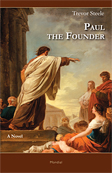
Trevor Steele:
Paul the Founder
(Angla traduko de lia Esperanto-romano "Paŭlo la fondinto")
(Angla traduko de lia Esperanto-romano "Paŭlo la fondinto")
ISBN 9781595694188
118 paĝoj.
Mole bindita libro.
The most important figure in the early years of Christianity, Paul the Apostle founded several Christian communities in Asia Minor and Europe from the mid-30s to the mid-50s AD...
8.5" x 5.5" (21,5 cm x 14 cm) Priskribo: The most important figure in the early years of Christianity, Paul the Apostle founded several Christian communities in Asia Minor and Europe from the mid-30s to the mid-50s AD. Shimeon bar Joseph, the younger brother of Yeshu (known to us as Jesus), compiles the story of Paulus, gathering information from a multitude of people who knew him: from Tobias, who tells anecdotes about his school years when he was still called Saul, from Barnabas, Silas, Titus, and other sources. This novel describes Paul as the real founder of the religion we now call Christianity, spreading the doctrines throughout the Empire, from Jerusalem to Antioch, to Ephesus, Corinth, Athens, Galatia, Philippi, Thessalonica, and many other cities. Shimeon bar Joseph presents to the reader a stern, courageous man, obsessed with his mission, and convinced that the end of the world is near - absolutely determined to carry the message of Yeshu to everyone. Trevor Steele (born in 1940) is an Australian author of novels and stories in Esperanto and English. He is one of the best-known writers of fiction in the international language, and - as in the case of Paul the Founder - many of his novels written originally in Esperanto have been translated by him into English. Klaku por vidi detalojn kaj kie aĉeti:
Aĉetu papere ĉe: UEA / Mondial / Amazon.com / Amazon.co.uk / Amazon.de / Amazon.ca / Amazon.jp / Amazon.es / Amazon.fr - aŭ uzu la supran ISBN-numeron aŭ la libro-titolon por serĉi ĉe alia reta librovendejo.
Aĉetu elektronike ĉe: (soon)
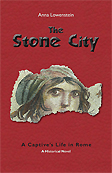
The Stone City
A Captive's Life in Rome
A Captive's Life in Rome
by Anna Lowenstein
ISBN 9781595693129
288 pages. A historical novel. The author's own English version of the successful Esperanto novel "La ŝtona urbo".
Snatched from her peaceful homestead in Celtic Britain, Bivana is transported to the legendary city of Rome. Struggling to come to terms with the loss of everyone and everything she has ever known, but determined to survive, she slowly adapts to a life of slavery and to the alien culture which surrounds her.
8.5" x 5.5" (21,5 cm x 14 cm) Description: Snatched from her peaceful homestead in Celtic Britain, Bivana is transported to the legendary city of Rome. Struggling to come to terms with the loss of everyone and everything she has ever known, but determined to survive, she slowly adapts to a life of slavery and to the alien culture which surrounds her. Her relationship with the slave Philon seems to promise a fresh start, but it also brings her into contact with the Nazarenes, activists in a fanatical new religious movement. When her own family is drawn into a clash with the authorities, she is forced to draw on all her resources to save them. --- Since its first publication in 1999, "The Stone City" has become well known and loved in its Esperanto translation, and has been translated by fans into French and Hungarian. This revised edition of the original English version includes several additional scenes. Anna Lowenstein became interested in the Romans when she visited Italy over thirty years ago, and was awestruck by her first view of the Pantheon. She wondered what impression it must have made on a barbarian who had never seen a stone building before, let alone architecture as magnificent as the houses and temples of Rome. That was the moment when she had the idea for her first novel "The Stone City". Not long afterwards she moved to Italy and came to live in the Roman countryside close to the ancient town of Palestrina, which appears in this novel under its Latin name Praeneste. Since then she has written a second novel, "Death of an Artist", also set in Ancient Rome, and is now working on a third.Details and where to buy:
perfect bound
To buy the paperback version: UEA / Mondial / Bookdepository / or use the ISBN number above to find it in your country's book seller websites like: amazon.com, amazon.co.uk, bookdepository and many others.
To buy an electronic copy: Google Play / Smashwords / Kindle / or search for title or ISBN number on your electronic device (Kindle, iBook; Nook, Sony Reader etc.)
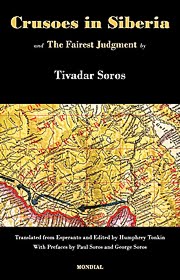
Crusoes in Siberia
by Tivadar Soros
transl. from Esperanto into English by Humphrey Tonkin
ISBN 9781595692184
132 pages. Novel, translated from Esperanto into English.
If you want to know where the brothers Paul and George Soros got their business skills, look no further than this little adventure story told by their father.
8.5" x 5.5" (21,5 cm x 14 cm) Description: In simple, understated style, Tivadar Soros tells how he and his companions broke out of their Siberian prisoner-of-war camp at the time of the Russian Revolution and traveled on foot through inhospitable mountains to freedom. And this was just preparation for the equally horrendous conditions that Tivadar and his family endured in World War II. Unfortunately, out there in the forest, I had no companion like Crusoe's Friday. My main helpers were an unquenchable desire to return home, and the easy equanimity that comes to a healthy person leading a wandering life. Tivadar Soros's memoir of Siberia ... is essentially an adventure story – a story of a young man's ingenuity and endurance. As a schoolboy, I used to join my father in the swimming pool after school, and after swimming he would regale me with an installment of his adventures. In this way they became an important part of my childhood. I and my brother consider it to be our good fortune to grow up observing how our father lived and dealt with the problems of the world.Details and where to buy:
perfect bound
To buy the paperback version: UEA / Mondial / Bookdepository / or use the ISBN number above to find it in your country's Amazon or other bookseller's websites.
To buy an electronic copy: Google Play / Smashwords / or search for title or ISBN number on your electronic device (Kindle, iBook; Nook, Sony Reader etc.)
Tivadar Soros
Humphrey Tonkin
George Soros
Paul Soros
Tivadar Soros (1894–1968)
was a Hungarian Jewish doctor, lawyer, author and editor. He was the father of Paul and George Soros. He fought in World War I and spent years in a prison camp in Siberia before escaping. He founded the Esperanto literary magazine Literatura Mondo (Literary World) in 1922 and edited it until 1924. He wrote the novels Modernaj Robinzonoj (Crusoes in Siberia) and Maskerado ĉirkaŭ la morto (Masquerade (dance) around death), an autobiographical novel about his experience during the Nazi occupation of Budapest, Hungary. Maskerado has been translated into English, Russian, German, Turkish, and Hungarian, Modernaj Robinzonoj into English and Italian.Source: en.wikipedia.org
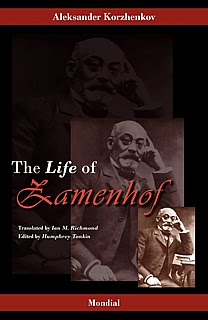
ZAMENHOF. The Life, Works and Ideas of the Author of Esperanto
by Aleksander Korzhenkov
transl. by Ian M. Richmond
ed. by Humphrey Tonkin
ISBN 9781595691675
114 pages.
This biography of Zamenhof was originally published in Esperanto; the present version, in Ian Richmond's excellent translation, is an abridged version of the original text, prepared for English readers by the author.
8.5" x 5.5" (21,5 cm x 14 cm) Description: Released to the public for the first time in in 1887, Esperanto had its specific origins in the fertile brain of a single individual, Zamenhof, and in the particular circum stan ces into which he was born and came of age. It is the story of these origins that Aleksander Korzhenkov's biography sets out to tell. That biography was originally published in Esperanto; the present version, in Ian Richmond's excellent translation, is an abridged version of the original text, prepared for English readers by the author. Zamenhof was a child of his times - buffeted by the social upheavals of Eastern Europe in the late nineteenth century, eager to find solutions to social ills, but alive to new ways of thinking that accompanied this change. Seeking to solve the specific problems of his own day, he created a language equally well suited to addressing those of ours. (Humphrey Tonkin) Published in coopeation with the Universal Esperanto Association.Details and where to buy:
perfect bound
To buy the paperback version: UEA / Mondial / Bookdepository / B&N.com / Jet.com or use the ISBN number above to find it in your country's Amazon or other bookseller's websites.
To buy an electronic copy: Google Play / Smashwords / or search for title or ISBN number on your electronic device (Kindle, iBook; Nook, Sony Reader etc.)
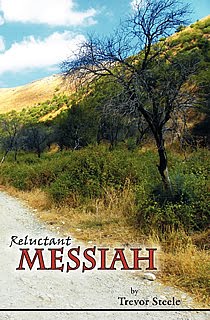
Reluctant Messiah
de Trevor Steele
transl. by Trevor Steele
ISBN 9781595691736
292 pages. Novel, translated from Esperanto into English.
This novel, based on a large amount of research, seeks to explore Jesus' actual life before he became an object of deification and falsification.
8.5" x 5.5" (21,5 cm x 14 cm) Description: Jesus' death - "triumph of a glorious illusion". This novel, based on a large amount of research, seeks to explore Jesus' actual life before he became an object of deification and falsification. It follows him from his humble birth, his gradual development of healing powers, his years as an Essene monk, his short campaign as a charismatic healer-preacher, to his ghastly death - and what happened after the death.Every page is packed with details of life at that time, its intellectual currents and political developments. This Jesus is an attractive human being who makes some mistakes, but inspires strong love and hatred. Incidentally, Judas Iscariot is shown to be not the betrayer but the loyallest follower of Jesus, and Mary Magdalene, the woman Jesus loved, was never a prostitute. The core text is the manuscript of Aurelius, an officer of the Roman army of occupation, who interviewed many people just a few years after the crucifixion and wrote this biography. But we read it through the eyes of a black American cardinal of the twenty-first century. -- Australian author Trevor Steele has published almost a dozen novels, collections of short stories, and travelogues in English and Esperanto.Details and where to buy:
perfect bound
To buy the paperback version: UEA / Mondial / Bookdepository / or use the ISBN number above to find it in your country's Amazon or other bookseller's websites.
To buy an electronic copy: Google Play / Smashwords / Kindle / or search for title or ISBN number on your electronic device (iBook; Nook, Sony Reader etc.)
His "resurrection" - a plot by Kaiaphas gone wrong.
List of works by Trevor Steele:
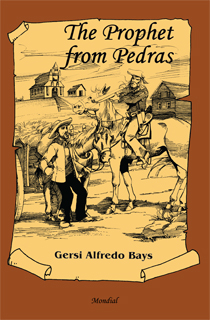
The Prophet from Pedras
by Gersi Alfredo Bays
transl. by Trevor Steele
ISBN 9781595692702
192 pages.
The Prophet from Pedras is humorous and tragic, full of the small and big stories life brings along.
8.5" x 5.5" (21,5 cm x 14 cm) Description: This English version of the novel is a translation from Esperanto. Translator: Trevor Steele. At the beginning of the 1930's, when the Brazilian version of fascism - the movement of the green shirts and the sigma symbol of the socalled "integralists" - appear in Southern Brazil, Ludvig Kapstein, a non-practicing Jew, decides to leave his city and move far away. He is nicknamed "Prophet" because of his long beard, his wisdom and his free spirit, and in the small town of Pedras somewhere at the Uruguay River, he finds his new home. Family, friends, his optimism and sense of innovation help him become one of Pedras' most respected citizens, until one day bandits show up... "The Prophet from Pedras" is humorous and tragic, full of the small and big stories life brings along. It was first published in 2000 under the title "La Profeto el Pedras" in the international language Esperanto and has been translated into Portuguese, Italian and Chinese. This English translation is by Australian writer Trevor Steele. The author, Gersi Alfredo Bays (*1934), is a publisher of Esperanto literature and was the editor of the literary magazine Fonto. He was a member of the Academy of Esperanto.Details and where to buy:
perfect bound
To buy the paperback version: UEA / Mondial / Bookdepository / or use the ISBN number above to find it in your country's Amazon or other bookseller's websites.
To buy an electronic copy: Google Play / Smashwords / or search for title or ISBN number on your electronic device (Kindle, iBook; Nook, Sony Reader etc.)
2. Libroj pri Esperanto
Books about Esperanto
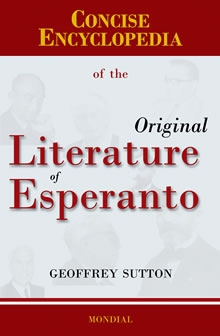
Concise Encyclopedia of the Original Literature of Esperanto
by Geoffrey Sutton
ISBN 9781595690906
740 pages.
This outstanding work of scholarly reference appears in English for the first time. No other such extensive descriptive work is available on this global cultural phenomenon. Esperanto is the only planned international language to have become the vernacular and literary medium of a widespread speech community. This work charts the evolution of its original literature from its humble beginnings in 1887 to its worldwide use in every literary genre in the present day. The work is a revelation for students of comparative and world literature.
8.5" x 5.5" (21,5 cm x 14 cm) Description: This outstanding work of scholarly reference appears in English for the first time. No other such extensive descriptive work is available on this global cultural phenomenon. Esperanto is the only planned international language to have become the vernacular and literary medium of a widespread speech community. This work charts the evolution of its original literature from its humble beginnings in 1887 to its worldwide use in every literary genre in the present day. The work is a revelation for students of comparative and world literature. The Concise Encyclopedia of the Original Literature of Esperanto contains: • a preface by Dr. Humphrey Tonkin, Professor of the Humanities and President Emeritus at the University of Hartford, Connecticut Esperanto literature is created by writers from many countries who have chosen to use it because of its merits. It is, as yet, nearly always a labour of love – that is to say a product of culture. It is also most fundamentally democratic – a product of people, as opposed to capital, power or national prestige. More generally, the precise nature of Esperanto culture is still debated. It is certain, however, that it is unusually aware. In contrast to other contemporary cultures, Esperanto-speakers are more likely to be acquainted with their poets, despite the lack of a state-financed education system. The beginnings of the philosophy behind Esperanto may be found in the work of Descartes. This philosophy is the concretization of an ideal that has been incubated by enlightened people for centuries: If all our mental processes and operations should be ruled by reason, then the first field into which we must introduce it is that means by which we express and interconnect our thoughts, which is language. (Gaston Waringhien). Leibnitz continued the work of Descartes. At the end of a French-language manuscript, discovered in Hanover Library in 1903, he wrote: When this project (of a universal language) is realized, the happiness of mankind will depend solely on themselves, because then they will have a tool at their disposal that will serve to increase their good sense as the telescope serves to increase the capacity to see … Esperanto is a vernacular and literary medium that belongs equally to all and to no one, used by people who are universally bilingual or multilingual and generally support language diversity. Details and where to buy:
hard cover with jacket
To buy the hardcover version: UEA / Mondial / Bookdepository / or use the ISBN number above to find it in your country's Amazon or other bookseller's websites.
To buy an electronic copy: Google Play
• a unique work of international reference
• an English-language companion for the literary enthusiast
• a 'must' for every serious library and media reference section
• a general introduction to Esperanto literature, its history, evolution and modern development
• individual introductions to the five periods of the literature
• over 300 individual articles on the most important writers and their work in chronological order, with biographies and critique
• sample literary texts from some of the best original authors
• an introduction to the language itself, its linguistic structure and creative capabilities
• extensive bibliographies and index
Esperanto is used on every continent as a neutral second language by people who wish to practise mutual respect for other cultures – and not merely advocate it. It has evolved naturally into a fully developed literary language, whose acquisition nevertheless does not necessitate the many years of study required by an ethnic language.
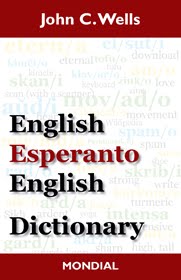
English-Esperanto-English Dictionary
by John C. Wells
ISBN 9781595691491
508 pages.
Find what you are looking for: Concise yet comprehensive, with coverage of all the words you need, including many technical terms. Both directions: Contains both Esperanto–English and English–Esperanto sections, with a total of over 30,000 entries. Keep up-to-date: Completely revised and rewritten, with a thorough coverage of contemporary English and Esperanto. Check how to write it and say it: With a grammatical introduction presenting a clear and authoritative analysis
8.5" x 5.5" (21,5 cm x 14 cm) Description: An essential resource for users and students of Esperanto.Details and where to buy:
perfect bound
To buy the paperback version: UEA / Mondial / Bookdepository / or use the ISBN number above to find it in your country's Amazon or other bookseller's websites.
To buy an electronic copy: Google Play / Smashwords / or search for title or ISBN number on your electronic device (iBook; Nook, Sony Reader etc.)
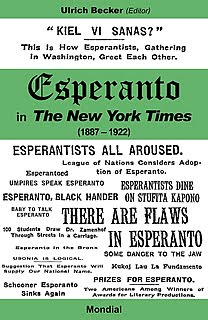
Esperanto in The New York Times
by Ulrich Becker (ed.)
ISBN 9781595691699
286 pages.
This book is a look back at the beginnings of the Esperanto movement (1887-1922) in the US and beyond, opening a window into contemporaneous accounts on the pages of a world-renowned newspaper.
8.5" x 5.5" (21,5 cm x 14 cm) Description: Some of the articles in this collection reflect aspects of the history of the Esperanto movement quite vividly; in others, we find odd anecdotes about Esperanto and the Esperantists; and many passionately-written letters from readers illustrate the ups and downs, the successes and conflicts of the Esperanto community, as well as its disputes with the skeptics outside their ranks. These first 35 years of the history of Esperanto seen from the vantage point of the New York Times show how Esperanto gradually became established in the US and in the world, carried on the high hopes of its early, idealistic proponents. The book is supplemented by an appendix containing an index of the names of persons mentioned in the newspaper articles, a short bibliography, and a collection of links to reliable information on Esperanto on the Internet.Details and where to buy:
perfect bound
To buy the paperback version: UEA / Mondial / Bookdepository / or use the ISBN number above to find it in your country's Amazon or other bookseller's websites.
To buy an electronic copy: Google Play/ Kindle
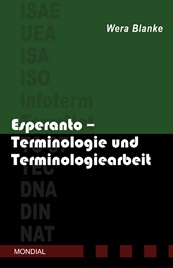
Esperanto – Terminologie und Terminologiearbeit
by Wera Blanke
ISBN 9781595690777
156 pages. Contributions in English and German.
Collection of texts in English and German about Terminological standardization, its roots and fruits in planned languages; i.a. about the influence of interlinguists and Esperanto speakers Eugen Wüster and Ernest Drezen on the development of international terminology standards.
8.5" x 5.5" (21,5 cm x 14 cm) Description: Collection of texts in English and German about Terminological standardization, its roots and fruits in planned languages; i.a. about the influence of interlinguists and Esperanto speakers Eugen Wüster and Ernest Drezen on the development of international terminology standards. Internationale Plansprachen, mit Esperanto als ihrem Hauptvertreter, lieferten grundlegende Impulse für die Begründung einer sprachen- und fachunabhängigen allgemeinen Terminologiewissenschaft durch den österreichischen Esperantologen und Ingenieur Eugen Wüster (1898-1977) und den lettischen Interlinguisten und Techniker Ernest Karlovic Drezen (1892-1937). Der vorliegende Band behandelt weitgehend unbekannte plansprachliche Aspekte der Terminologiewissenschaft sowie Ergebnisse terminologischer Aktivitäten in der Sprachgemeinschaft des Esperanto. Wera Blanke (*1933), Berlin, hatte verschiedene Berufe, darunter Farbfilm-Lichtbestimmerin, Schauspielerin, Arbeits- und Gestaltungstherapeutin; beschäftigt sich seit 1979 mit der Bildung von Fachwörtern in Esperanto; arbeitete u.a. über die plansprachlichen Impulse für die Entstehung der Terminologiewissenschaft; initiierte 1985 das Terminologische Zentrum des Esperanto-Weltbundes (Universala Esperanto-Asocio, Rotterdam); hielt zahlreiche Vorträge und veröffentlichte vor allem in Deutsch und Esperanto; erhielt 2006 auf Anregung des Internationalen Informationszentrums für Terminologie (Infoterm, Wien) den „Eugen-Wüster-Sonderpreis“.Details and where to buy:
perfect bound
To buy the paperback version: UEA / Mondial / Bookdepository / or use the ISBN number above to find it in your country's Amazon or other bookseller's websites.
To buy an electronic copy: Google Play
